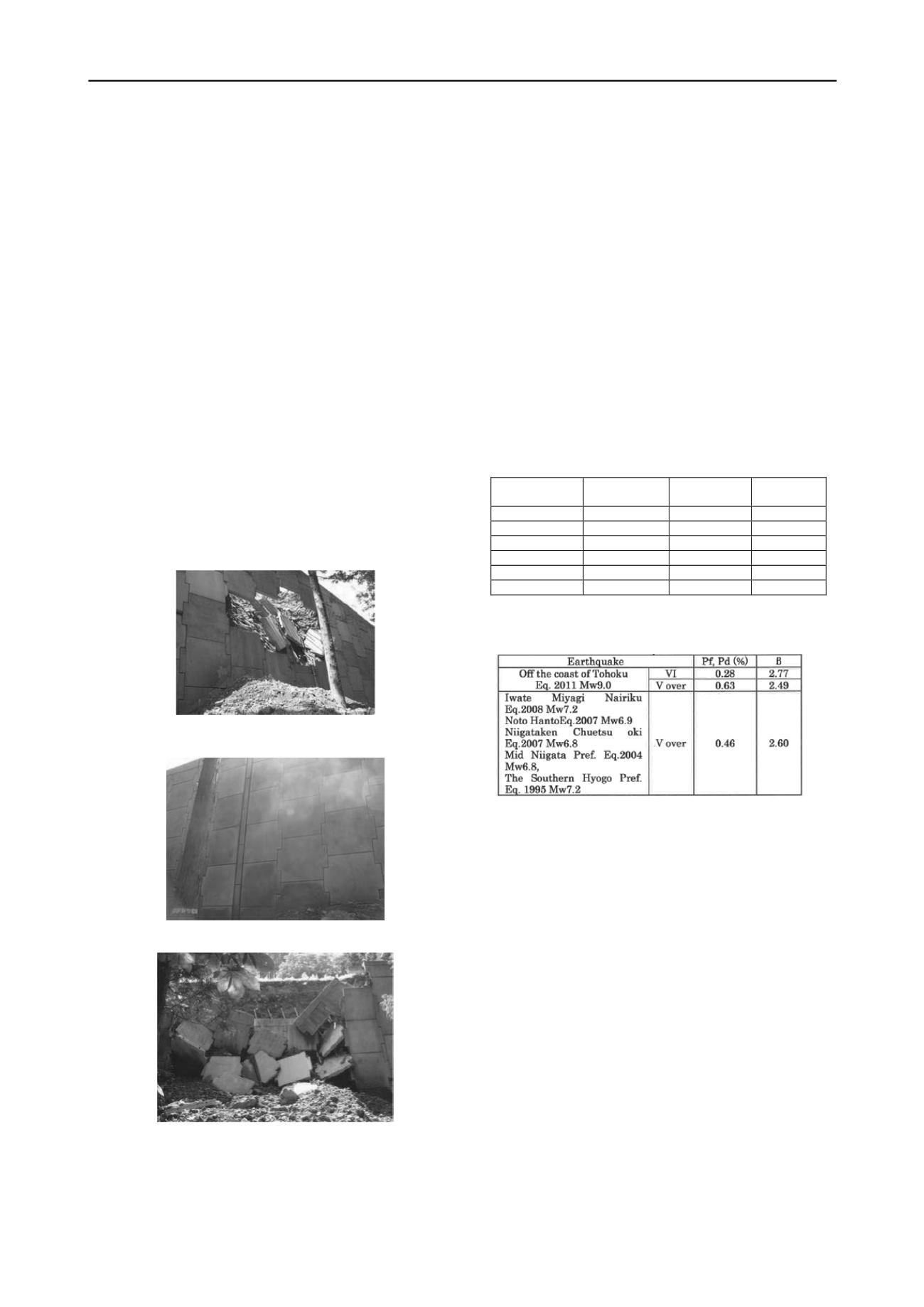
1566
Proceedings of the 18
th
International Conference on Soil Mechanics and Geotechnical Engineering, Paris 2013
2.4
Example of damaged structure due to combined factors
(frost heave phenomenon)
2.4.1
< Case 4.1 wall H
max
= 13.0 m, bank h = 5.0 m, L =
900 m, A = 7,600 m
2
>
At a site where panels covering a Reinforced Earth wall
deformed and collapsed (Photo 7) because of frost heave
phenomenon while the structure was being constructed, part of
the structure suffered further damage as a result of being hit by
the 2008 Iwate-Miyagi Inland Earthquake, which registered a
seismic intensity of upper 6. As a countermeasure against frost
heave, it was decided to install a backside filter layer (non-
susceptible to frost heave) and to substitute the existing earth
fill with superior-quality earth fill (these measures are in
accordance with the current standard
1)
for locations where
deformation exists). While these measures were being
implemented, the structure was subjected again to tremors from
the 2011 Tohoku Earthquake, registering a seismic intensity of
upper 5 at that location. The survey carried out this time
revealed that sections of the wall where anti-frost heave
measures were implemented, only rated Damage Rank I (Photo
8). On the other hand, sections where the measures had not yet
been implemented resulted in Damage Rank VI (Photo 9). In
the latter sections, it is likely that the connections between
reinforcing strips and panels had already been damaged due to
accumulated displacement brought about by prior frost heave.
Photo 7. Collapse of facing panels by frost heaving of backfill.(Before
2008 the Iwate Miyagi Nairiku Earthquake)
Photo 8. No damage Section of Anti-frost heaving (
After the 2011
Tohoku Earthquake
)
Photo 9. Collapse of facing panels in the sections where no fill
substitution had taken place (After the 2011 Tohoku Earthquake`)
3 EVALUATION OF EARTHQUAKE RESISTANCE
PERFORMANCE
The earthquake resistance performance of Reinforced Earth
(Terre Armee) walls was evaluated based upon the probability
of deformation/failure observed in the earthquake together with
survey results of damage inflicted by past earthquakes. Distress
that could be classified as Damage Rank VI was observed for
the first time in Japan with the Tohoku Earthquake. With the
probability of failure (Pf), which was the ratio of fractured
structures among the surveyed number of structures, the limit
state of damage suffered was calculated through safety index
(
) under the assumption that distributions of both seismic force
and seismic resistance follow normal distributions. Damage
rankings were determined from required structural performance
levels shown in Table 2. The probability of deformation (Pd) for
Damage Rank V or higher cases (at which the possibility of
repairing the damage becomes more than that for slight
damage), together with the values of this probability for past
earthquakes, are shown in Table 3. Although this Tohoku
Earthquake caused damage more severe than that inflicted by
past quakes, the value of safety index
f
= 2.77 indicates that a
comparatively high level of safety was maintained; particularly
when considering that
f
usually falls between 2.0 and 3.5 for
general civil engineering structures
4
.
Table 2. Demand for damage rank
Damage Rank
Serviceability
Structural
stability
Safety
VI
L
L
M
V
M
M
H
IV
M
H
H
III
M
H
H
II
H
H
H
I
H
H
H
* H: High M: Middle L: Low
Table 3. Evaluation of seismic performance
4 CONCLUSIONS
Some 40 years have passed since the Reinforced Earth
technique was introduced in Japan. Structures built with this
method have been subjected to many large-scale earthquakes
including the Tohoku Earthquake of March 2011 in which the
rate of high structural damage was quite small. Over 98% of the
numerous local Reinforced Earth walls examined after the
Tohoku Earthquake had only light to non-existent damage. As
demonstrated in this and many other earthquake-related
disasters, the seismic resistance of these structures has proven
that the technique is outstanding in terms of its operational
reliability and safety.
5 REFERENCES
1). Public Works Research Center. 2003.
Reinforced Earth Wall (Terre
Armee) Method-Based Design and Construction, 3rd Edition.
2). Public Works Research Center, 2005.
Damage Level Evaluation and
Report of Basic Policy Reviewing Committee for Restoration of
Disaster Damages.
3). Japan Terre Armee Association. 2011.
2nd Investigation of the 2011
Off the Pacific Coast of Tohoku Earthquake
.
4). Masaru Hoshiya, 1986.
Reliability Based Design for Structures
.
Kajima Institute Publishing
.


